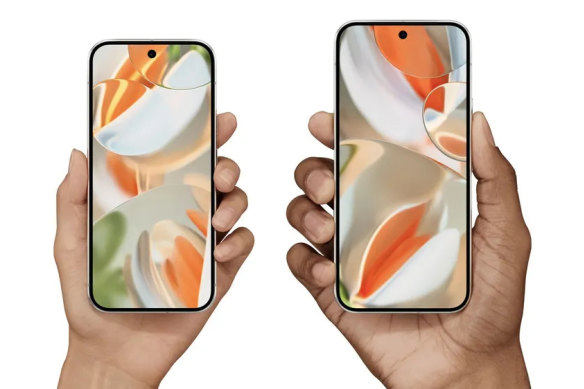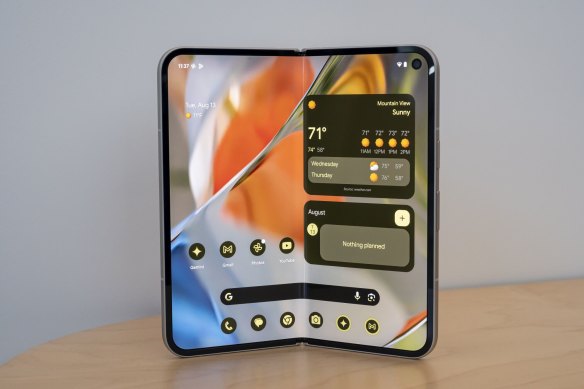- Review
- Technology
- Phones
This was published 10 months ago
Google’s Pixel 9 Pro approaches AI overload, but it’s still a fantastic phone
By Tim Biggs
Google’s ninth generation of smartphones arrives with an even bigger focus on AI than before, and an even bigger price tag that’s unabashedly approaching Apple territory. But after spending some time with the highest-end device, it’s clear that the latest Pixels remain focused on showcasing everything Android phones can do, and packaging the best of Google’s services and capabilities into a sleek and helpful personal device.
Physically the Pixel 9 Pro XL is a beautiful phone with a glossy metal frame and an elongated camera bar across the back. I do think the colour choices are a little unfortunate though, with only fairly muted colours for the Pro device, while the less expensive Pixel 9 gets a bright green and hot pink. My grey review unit (Google calls it Hazel) looks great, but a pop of colour would be nice.
The phone is powered by a new Google processor and 16GB of RAM, which makes for excellent performance across multitasking and games, while also providing some headroom for the increasing amount of on-device AI-processing smartphones have to do. The 6.8-inch 120Hz OLED screen hits an incredible peak brightness of 3000 nits, making it easy to see in the sun.
And perhaps most importantly, Google continues to offer the cleanest, smoothest and most convenient flavour of Android. All the built-in apps (from the transcribing recorder and the revamped weather forecast) are things you’ll need, with no annoying bloat or pre-installed ads, and more than any other Android platform, the Pixel feels relaxed and easily customisable without making anything too crowded or overwhelming. Google is promising seven years of operating system and security updates.
All about AI
As you’d expect, this new phone is filled with generative AI features, starting with the Gemini chatbot, which replaces the Google Assistant. It will still automatically talk to the old assistant when it needs to (for example, if you ask for a timer or to modify your smart lights), but it will also quickly respond with full answers to questions such as, “what do I need to make black bean burritos”, or prompts like “write a description of a main character in a detective novel”. You can type or talk to the assistant, but the conversation-like “Live” mode is locked to Gemini Advanced, which you only get through paid subscriptions.

The Pixel 9 currently comes in a smaller standard model and a larger Pixel 9 Pro XL, with a smaller Pro releasing soon.
Pixel Studio is a new image generation app, which works quickly and is free, but will really be useful only if you frequently need very specific illustrations and don’t mind the odd uncanny error. It will decline to make realistic pictures of people, but if you want a cartoon of your dog playing tennis or a pixel art background of a chicken nugget warrior it does a good job. Some people might find themselves coming back often to fill up their roster of meme reaction stickers, since you can get more specific options here than you’d get Googling for an existing picture, but I’m pretty sure I’m never going to open the app again after this week.
In contrast, Pixel Screenshots is a feature I feel like I could end up using a lot. Once you’ve opted in, all your screenshots are viewable in a dedicated Screenshots app, where any text and images are analysed and presented with AI-generated summaries. You can search for “dog” or “receipts” to bring up matching results, or you can ask queries such as: “How much was that TV?” And the app will answer in a sentence. You can also add images from your gallery or open the camera direct from the Screenshots app to capture something, which is handy if you tend to take photos of things (signs, book pages) that you want to remember later. And not only is it now easier to use pictures as a memory aid, but my camera roll isn’t constantly filled with boring junk.
Outside these features, quieter examples of AI continue to make the Pixel an excellent overall smartphone, from improving call quality and even answering suspicious incoming calls for you, to being able to pull up web results on anything you see if you circle it.

A folding version of the Pixel 9 Pro is also coming soon.Credit: Bloomberg
Taking photos
Pixels have long had incredible point-and-shoot cameras that regularly outperform other premium smartphones, and that continues here. On the Pro model, a new 42MP front camera hands in great selfies in almost all lighting conditions, and can pull back wide for group shots. On the rear, the combo of wide, ultra-wide and telephoto gives clean results as close as 2 centimetres from the subject (given enough light and a steady hand) and as far as 10x zoom.
In like-for-like conditions, Google produces the most true-to life-pictures compared with current Apple and Samsung phones, in my opinion. Colours are not over-saturated or too warm, and artificial lighting tends to be correctly accounted for. Portrait blurring and panorama mode are certainly not infallible, but generally look great.
However, the clear focus for Google in building its photography system going forward is in AI tools, which are more numerous than ever in the Pixel 9 Pro. And while they all work, the results do invariably have an AI air about them, and applying AI editing to personal photos continues to feel a bit less comfortable than your usual cropping and filters.

Even at more than 10x zoom, the Pixel 9 Pro captures some very nice images.Credit: Tim Biggs
A new feature called Zoom Enhance is more or less that magical technique used by TV detectives on CCTV stills, except in this case it’s using generative AI to guess what something would look like in greater detail than the camera actually captured. If you’re zoomed in more than 15x, this feature will automatically apply when you take the picture, but you can also edit any photo you’ve taken with the phone, zoom in and activate Zoom Enhance to clean it up. It works better than the blurry or pixelated results you’d expect on most phones, but the pictures absolutely end up with telltale AI artefacts like strange skin textures, wrong colours or heavy inky lines.
Add Me, another new feature, is designed to address that common problem where you’re not in a group photo because you were the one taking the photo. You activate the mode, take the photo, then hand the phone to a friend and go to where the group just was. Your friend will see you superimposed on the photo you took, and when they hit the shutter the system will stitch it all together. The feature has problems if it needs to put you on a plush couch or in complex shadows, but it’s as competent as a pretty good Photoshop.
And more AI
The AI-powered Magic Editor, which you can use to touch up even the oldest photos taken on other phones, also has some new features. Auto Frame will analyse a photo and give you some framing options to choose from based on different photography techniques. It might straighten, crop, zoom or even step back away from the subject. Obviously, many of these options require the AI to completely invent new surroundings, so results will vary.
In one example, I reframed a photo of my son taken from behind, while he was riding a scooter. The system flipped it from portrait to landscape orientation, and moved the subject from the middle of the shot to the bottom third, which at first glance makes for a much better photo. But it also means around half of the photo is completely fake, and if you look closely you can see melted-looking car bodies, power lines that don’t connect to anything, and what appears to be a stack of cement blocks with bits of hi-vis stuck to them.
The Re-imagine option in Magic Editor is a bit more directed, in that you can highlight any photo element (as though you were going to remove it with the Magic Eraser) and type in a text prompt to transform it. That could mean asking for fireworks in the sky behind you, or turning an unwanted “no smoking” sign into a band poster. As ever with these things, some results are near-indistinguishable from reality, and some are completely wretched.
For video, most AI features arrive when you switch on something called Video Boost, which sends your backed-up videos to a Google server for processing. The video you take is available instantly, but it generally takes a few hours for the boosted version to arrive. Boosting smooths out blur and adds in details for videos zoomed in past 5x, fixes colour, makes low-light footage much more discernible and optionally increases resolution to 8K so you can take decent stills from the video. In my limited testing it did an excellent job at improving nighttime video, just like Night Sight does for still photos. I’m keen to try it out at a concert though and see how the AI deals with capturing a performer’s details at a distance and with a lot of movement.
Get news and reviews on technology, gadgets and gaming in our Technology newsletter every Friday. Sign up here.